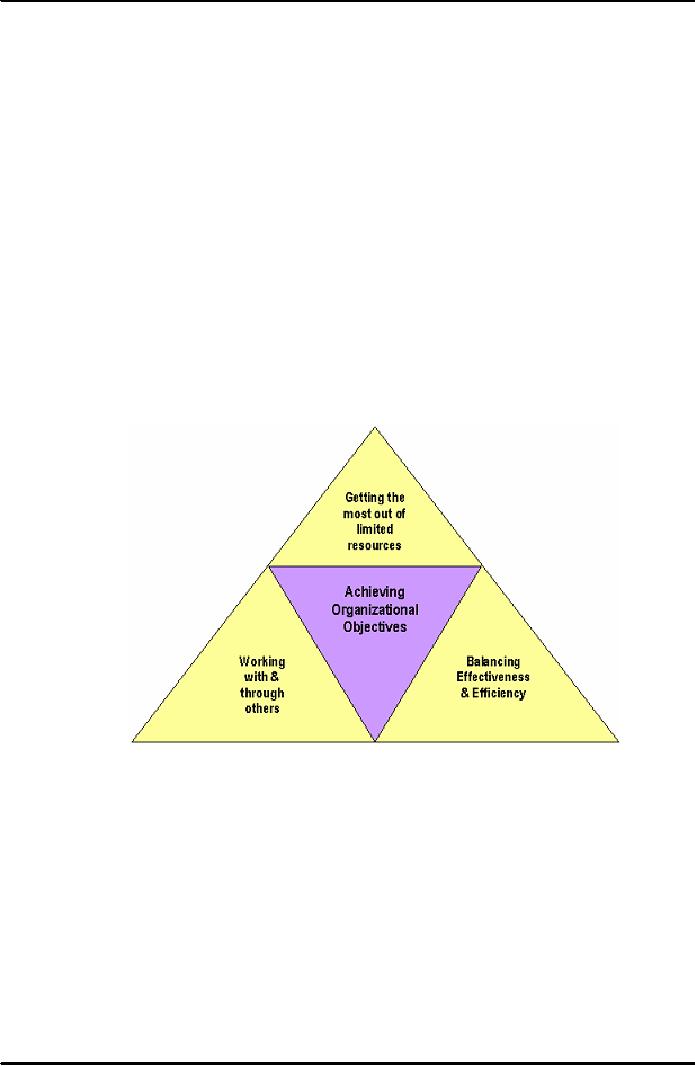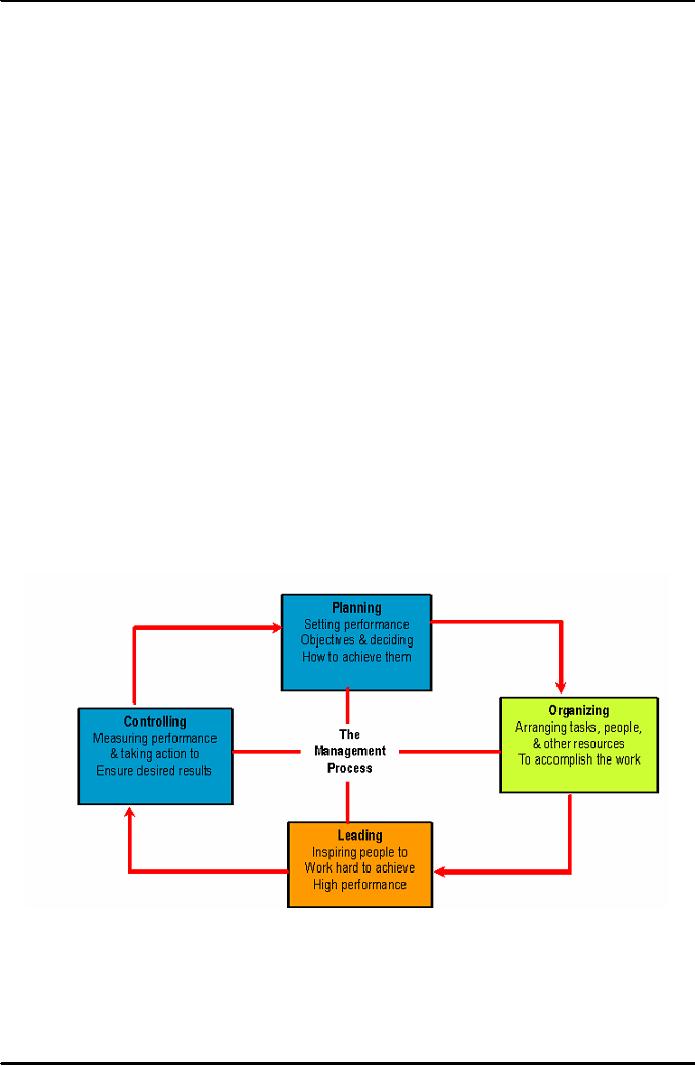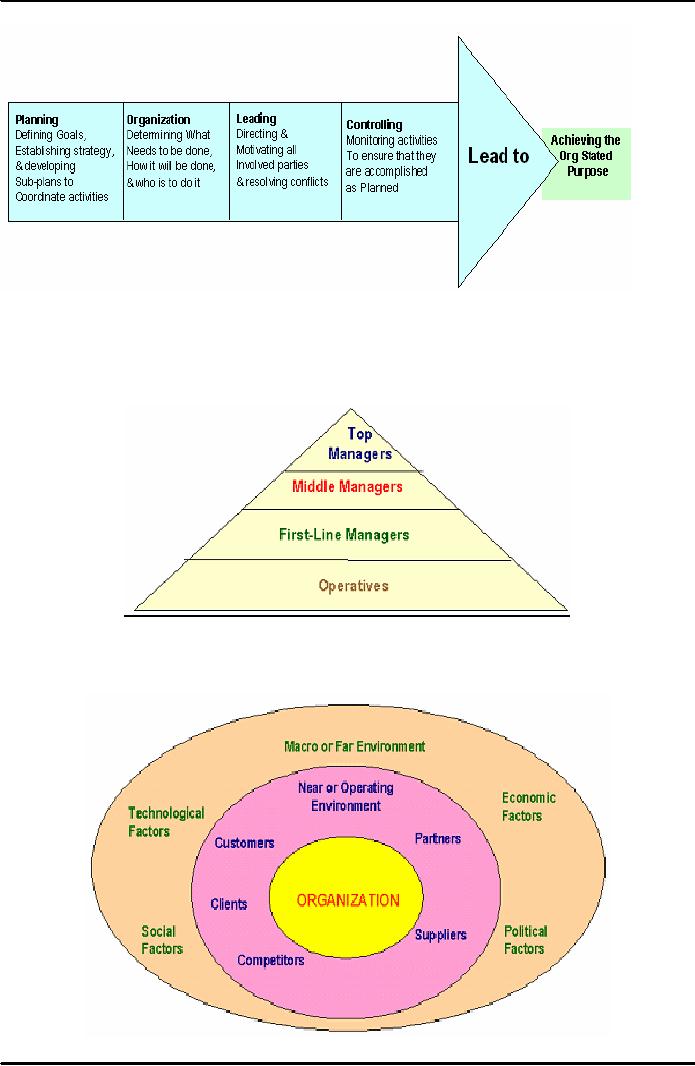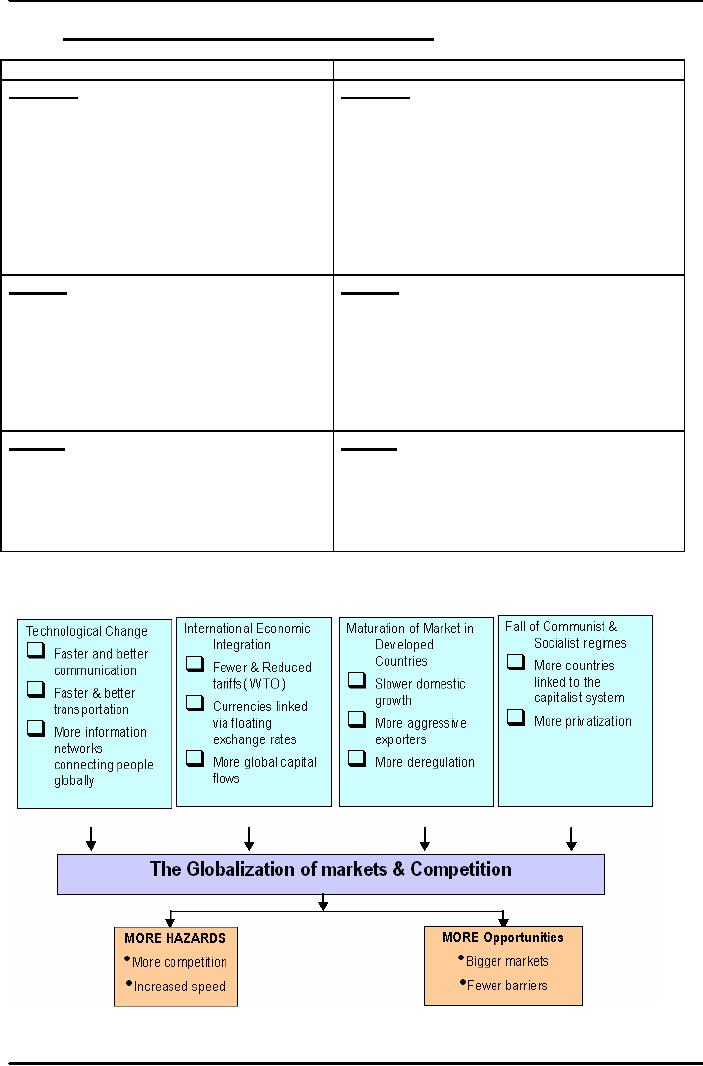 |
INTRODUCTION TO PROJECT MANAGEMENT:Broad Contents, Functions of Management |
| CONCEPTS, DEFINITIONS AND NATURE OF PROJECTS:Why Projects are initiated?, Project Participants >> |

Project
Management MGMT627
VU
LESSON
01
INTRODUCTION
TO PROJECT MANAGEMENT
Broad
Contents
�
Management
�
Key
management concepts
�
Functions
of management
Comparison
of 20th and 21st
century
organizations
�
1.1
What
is Management?
Managing
is an
art of getting things done
through and with people in
formally organized
groups.
Management
is the
process of designing and maintaining an
environment in which
individuals,
working
together in groups, efficiently accomplish
selected aims towards any
project. It is the
art
of creating an environment in which
people can perform as
individuals and yet
cooperate
towards
the attainment of group goals.
1.1.1
Management
as a Process:
According
to this, management is the process of
using organizational resources
to
achieve
the organization's goals through
planning,
organizing, leading, and
controlling. It is
thus, a set of activities
directed at an organization's resources
with the
aim
of achieving organizational goals in an
efficient
and
effective
manner.
1.1.2
Management
as People:
This
refers to a group of people who
engage in "Process of
Management".
1.2
Key
Management Concepts:
�
Project
Organization: It
comprises of people working
together and coordinating
their
actions
to achieve specific goals.
�
Goal:
A
desired future condition that the
organization seeks to achieve.
�
Resource:
An
asset, competency, process,
skill, or knowledge controlled by
organization.
Various
types of resources that an organization
possesses are as
follows:
o
People
o
Information
o
Machinery
o
Financial
capital
o
Raw
Materials
A
resource is strength, if it provides an
organization with a competitive
advantage. On the
contrary,
a resource is a weakness; if it is something the
organization does poorly or
does not
have
capacity to do. Organizational
resources include: Human,
Physical, Financial,
Technological,
and Information.
1.3
Evolution
of Management Concept in Modern
Era:
a)
Frederick Taylor Father of
Scientific Management was a
Mechanical Engineer. He
invented
high speed steel cutting
tools. He got the opportunity to
know first hand problems
and
attitudes of the workers. Based on
these he identified that in
order to improve the
quality
of management, the major concern
was to increase
efficiency in production,
lower
cost,
raise profits through higher
productivity, and also increase the
pays/salaries of the
workforce.
1

Project
Management MGMT627
VU
His
message of management was to
give people their best
opportunities to be productive,
and
in turn reward workers for
their individual productivity.
This increase in
labor
productivity
is not possible without the
following:
�
Providing
ample rewards
�
Adequate
trainings
�
Continuous
managerial support
Thus,
Fredrick Taylor concluded
that "low
productivity in any project is
matter of
ignorance
on part of labor and
management".
b)
Henry L. Gantt stressed
the importance of "developing
understanding of systems both
for
labor
as well as management." He
emphasized that in all problems of
management, human
element
is the most important one.
Gantt
gave graphic methods of describing
project plans in order to have better
managerial
control.
He highlighted the importance of time and
cost in planning and controlling
projects.
He
made the famous Gantt
chart which
is the forerunner of PERT.
1.4
Key
Aspects of the Management
Process:
The
key aspects of the Management
Process can be explained
with the help of the
following
diagram:
Figure
1.1: Management
Process Aspects
1.5
Functions
of Management:
The
process of management consists of
four basic managerial
functions. These are:
a)
Planning:
Planning
is the process of setting objectives in
any project and then
determining what
should
be done to accomplish them. It is a capstone activity
of management. Managers at
every
level do planning. Planning
activities determine an organization's
objective and based
on
these helps it in establishing
appropriate strategies for
achieving them. These
strategies
provide
the organization with the direction
and serves to obtain a match
between the
external
environment and internal capabilities.
The strategies are intended
to achieve a
sustained
competitive advantage over the
competitors.
2

Project
Management MGMT627
VU
b)
Organizing:
Organizing
is the process of assigning tasks,
allocating resources, and arranging
coordinated
activities
to implement plans. It involves
establishing intentional structure of roles
for
people
to fill in organizations.
c)
Leading:
Leading
is the process of arousing enthusiasm and
directing human resource efforts
toward
project
and organizational goals. It involves
influencing people so that
they contribute
towards
organizational and group goals.
Leadership predominantly is concerned
with the
interpersonal
aspect of managing.
In
projects most important problems arise
from people in terms of
their desires,
attitudes,
and
behavior (as individuals as
well as in groups). Thus, effective
project managers also
need
to be effective leaders.
Leadership
implies follower-ship and people
tend to follow those who
offer means of
satisfying
their own needs, wishes, and
desires.
d)
Controlling
Controlling
is the process of measuring performance and taking
actions to ensure desired
results
in any project. It involves measuring and
correcting individual as well
as
organizational
performance to ensure that events
conform to plans.
Controlling
facilitates accomplishment of plans. There are three
basic elements that
are
involved
in controlling. These are:
1.
Management should establish standards of
performance.
2.
Performance should be assessed
periodically and information should be
updated that
indicates
deviation between actual versus the established
standards.
3.
Actions should be taken to correct
performance that does not
conform to the standards.
1.6
Management
Functions: Planning, Organizing,
Leading & Controlling:
Figure
1.2: Management
Functions
3

Project
Management MGMT627
VU
1.7
Managerial
Functions in Organizations Undertaking
Projects:
Figure
1.3: Managerial
Functions
Organizations
are arranged in ways that try to
maximize synergy,
i.e. the ability of the whole
to
equal
more than the sum of its
parts.
This means that an
organization ought to be able
to
achieve
its goals more effectively and
efficiently than would be possible if the
parts operated
separately.
Organizations comprise of various levels.
These are depicted in the
following figure:
Figure
1.4: Various
organizational levels
Figure
1.5: A
model for organizational
environment
4

Project
Management MGMT627
VU
Comparison
of 20th And
21st Century
Organizations:
1.8
20th Century Organizations
21st Century Organizations
Structure
Structure
�
Bureaucratic
�
Not
bureaucratic, with fewer rules and
�
Multi-leveled
employees
�
Limited
to fewer levels
�
Organized
with the expectation that
senior
�
Organized
with the expectation
that
management
will manage
�
Characterized
by policies and
procedures
management
will lead, and
lower-level
employees
will manage.
that
create many complicated
internal
�
Characterized
by policies and procedures
that
interdependencies
produce
the minimal internal
interdependence
needed
to serve customers.
Systems
Systems
�
Depend on
few performance information
�
Depend on
many performance information
systems.
system,
providing data on
customers
�
Distribute
performance data to executives
especially
�
Distribute
performance data widely
only
�
Offer
management training and support
�
Offer
management training and support
systems
to many people
systems
to senior people only
Culture
Culture
�
Inwardly
focused
�
Externally
oriented
�
Centralized
�
Empowering
�
Slow
to make decisions
�
Quick
to make decisions
�
Political
�
Open and
candid
�
Risk
averse
�
More
risk tolerant
1.9
Economic
And Social Forces Driving
Need For Major Changes in
Organizations:
This
is illustrated in the following
figure:
Figure
1.6: Economic and
Social changes driving
change
5

Project
Management MGMT627
VU
In
order to have large scale
changes in organizations, there are
some distinctive
transformation
processes.
These are as follows:
�
Reengineering
�
Restructuring
�
Quality
programs
�
Mergers
and acquisitions
�
Strategic
changes
�
Cultural
changes
1.10
Paradigm
Shifts:
To
From
Information
Society
Industrial
Society
High
Tech/High Touch
Forced
Technology
World
Economy
National
Economy
Long
Term
Short
Term
Decentralization
Centralization
Self-Help
Institutional
Help
Participatory
Democracy
Representative
Democracy Hierarchies
South
North
Multiple
Option
Either/OR
6
Table of Contents:
- INTRODUCTION TO PROJECT MANAGEMENT:Broad Contents, Functions of Management
- CONCEPTS, DEFINITIONS AND NATURE OF PROJECTS:Why Projects are initiated?, Project Participants
- CONCEPTS OF PROJECT MANAGEMENT:THE PROJECT MANAGEMENT SYSTEM, Managerial Skills
- PROJECT MANAGEMENT METHODOLOGIES AND ORGANIZATIONAL STRUCTURES:Systems, Programs, and Projects
- PROJECT LIFE CYCLES:Conceptual Phase, Implementation Phase, Engineering Project
- THE PROJECT MANAGER:Team Building Skills, Conflict Resolution Skills, Organizing
- THE PROJECT MANAGER (CONTD.):Project Champions, Project Authority Breakdown
- PROJECT CONCEPTION AND PROJECT FEASIBILITY:Feasibility Analysis
- PROJECT FEASIBILITY (CONTD.):Scope of Feasibility Analysis, Project Impacts
- PROJECT FEASIBILITY (CONTD.):Operations and Production, Sales and Marketing
- PROJECT SELECTION:Modeling, The Operating Necessity, The Competitive Necessity
- PROJECT SELECTION (CONTD.):Payback Period, Internal Rate of Return (IRR)
- PROJECT PROPOSAL:Preparation for Future Proposal, Proposal Effort
- PROJECT PROPOSAL (CONTD.):Background on the Opportunity, Costs, Resources Required
- PROJECT PLANNING:Planning of Execution, Operations, Installation and Use
- PROJECT PLANNING (CONTD.):Outside Clients, Quality Control Planning
- PROJECT PLANNING (CONTD.):Elements of a Project Plan, Potential Problems
- PROJECT PLANNING (CONTD.):Sorting Out Project, Project Mission, Categories of Planning
- PROJECT PLANNING (CONTD.):Identifying Strategic Project Variables, Competitive Resources
- PROJECT PLANNING (CONTD.):Responsibilities of Key Players, Line manager will define
- PROJECT PLANNING (CONTD.):The Statement of Work (Sow)
- WORK BREAKDOWN STRUCTURE:Characteristics of Work Package
- WORK BREAKDOWN STRUCTURE:Why Do Plans Fail?
- SCHEDULES AND CHARTS:Master Production Scheduling, Program Plan
- TOTAL PROJECT PLANNING:Management Control, Project Fast-Tracking
- PROJECT SCOPE MANAGEMENT:Why is Scope Important?, Scope Management Plan
- PROJECT SCOPE MANAGEMENT:Project Scope Definition, Scope Change Control
- NETWORK SCHEDULING TECHNIQUES:Historical Evolution of Networks, Dummy Activities
- NETWORK SCHEDULING TECHNIQUES:Slack Time Calculation, Network Re-planning
- NETWORK SCHEDULING TECHNIQUES:Total PERT/CPM Planning, PERT/CPM Problem Areas
- PRICING AND ESTIMATION:GLOBAL PRICING STRATEGIES, TYPES OF ESTIMATES
- PRICING AND ESTIMATION (CONTD.):LABOR DISTRIBUTIONS, OVERHEAD RATES
- PRICING AND ESTIMATION (CONTD.):MATERIALS/SUPPORT COSTS, PRICING OUT THE WORK
- QUALITY IN PROJECT MANAGEMENT:Value-Based Perspective, Customer-Driven Quality
- QUALITY IN PROJECT MANAGEMENT (CONTD.):Total Quality Management
- PRINCIPLES OF TOTAL QUALITY:EMPOWERMENT, COST OF QUALITY
- CUSTOMER FOCUSED PROJECT MANAGEMENT:Threshold Attributes
- QUALITY IMPROVEMENT TOOLS:Data Tables, Identify the problem, Random method
- PROJECT EFFECTIVENESS THROUGH ENHANCED PRODUCTIVITY:Messages of Productivity, Productivity Improvement
- COST MANAGEMENT AND CONTROL IN PROJECTS:Project benefits, Understanding Control
- COST MANAGEMENT AND CONTROL IN PROJECTS:Variance, Depreciation
- PROJECT MANAGEMENT THROUGH LEADERSHIP:The Tasks of Leadership, The Job of a Leader
- COMMUNICATION IN THE PROJECT MANAGEMENT:Cost of Correspondence, CHANNEL
- PROJECT RISK MANAGEMENT:Components of Risk, Categories of Risk, Risk Planning
- PROJECT PROCUREMENT, CONTRACT MANAGEMENT, AND ETHICS IN PROJECT MANAGEMENT:Procurement Cycles